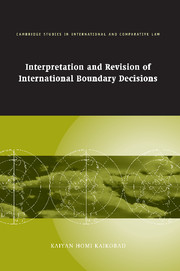Book contents
- Frontmatter
- Contents
- List of maps
- Preface
- Acknowledgments
- Table of cases
- List of abbreviations
- Part I Introduction
- Part II The settlement of territorial and boundary disputes
- Part III Judicial remedies: interpretation
- Part IV Judicial remedies: revision
- 7 The revision of judgments and awards
- 8 General features of revision
- 9 The classification of the notion of revision
- 10 Issues of admissibility
- 11 Selected substantive and procedural aspects of revision
- Part V Conclusions
- Select bibliography
- Index
- CAMBRIDGE STUDIES IN INTERNATIONAL AND COMPARATIVE LAW
10 - Issues of admissibility
Published online by Cambridge University Press: 14 September 2009
- Frontmatter
- Contents
- List of maps
- Preface
- Acknowledgments
- Table of cases
- List of abbreviations
- Part I Introduction
- Part II The settlement of territorial and boundary disputes
- Part III Judicial remedies: interpretation
- Part IV Judicial remedies: revision
- 7 The revision of judgments and awards
- 8 General features of revision
- 9 The classification of the notion of revision
- 10 Issues of admissibility
- 11 Selected substantive and procedural aspects of revision
- Part V Conclusions
- Select bibliography
- Index
- CAMBRIDGE STUDIES IN INTERNATIONAL AND COMPARATIVE LAW
Summary
Preliminary observations
Where it invokes a vested right of revision under the Statute of the International Court of Justice, the applicant State must satisfy the criteria provided in Article 61. As stated above, paragraph 2 of this provision obliges the Court to decide by way of judgment whether or not a decisive new fact exists such as to lay the case open to revision. Thus it is for the applicant State first to establish the admissibility of the request, and, once this is established, the Court will give leave to proceed to the second stage for the purposes of examining the request on its merits. For purposes of admissibility, the State claiming revision will have to fulfil both substantive as well as procedural criteria. Indeed, it is essential to state here that all of the relevant criteria have to be established to the satisfaction of the Court; even if only one of the conditions remains fully to be established, the Court will refuse to admit the case. It was this point that the Chamber of the International Court of Justice emphasised in El Salvador v. Honduras, discussed below in section II.
At any rate, this two-step procedure is also to be found in Article 38 of the International Law Commission's 1958 Draft Rules on Arbitral Procedure and in Articles 55 and 83 of the Hague Conventions of 1899 and 1907.
- Type
- Chapter
- Information
- Interpretation and Revision of International Boundary Decisions , pp. 265 - 301Publisher: Cambridge University PressPrint publication year: 2007

